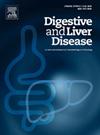多参数磁共振成像可以提高对高危MASH患者的检测:肝病临床的真实世界经验。
IF 3.8
3区 医学
Q1 GASTROENTEROLOGY & HEPATOLOGY
引用次数: 0
摘要
背景:早期识别有代谢功能障碍相关脂肪性肝炎(MASH)和/或晚期纤维化(AF)风险的代谢功能障碍相关脂肪性肝病(MASLD)患者可以预防疾病进展。非侵入性检查有助于识别高危患者。目前的指南建议主要使用纤维化-4 (FIB-4)评分进行风险分层。我们的目的是评估利用多参数磁共振(mpMR)成像提高对高危MASLD患者的检测的潜在益处。方法:在一项前瞻性多中心观察性研究中,纳入了接受mpMR作为标准临床治疗一部分的MASLD患者。提取患者人口统计数据、临床、实验室和影像学数据。比较了基于初始FIB-4和mpMR风险分层的疑似或已确诊MASLD患者的现行指南。cT1≥800 ms被认为是进展的高风险指标。结果:在两个大型学术中心的102例MASLD患者中,77%的患者FIB-4低(65例)。58%的低FIB-4患者cT1≥800 ms,表明发生MASH的风险增加(≤65组为63.5%,> - 65组为48.1%)。在≤65岁的患者中,cT1≥800 ms的患者多为女性(63.6% vs . 36.4%, p < 0.01),糖尿病发生率较高(30.3% vs . 5.3%, p = 0.03)。血脂异常很常见(65%的患者),但只有51.5%的患者接受降脂治疗。结论:在mpMR的实际应用中,超过一半的FIB-4分级为低风险的患者有cT1,这表明发生MASH或AF的风险增加。对于疑似或已确诊的MASLD患者,将mpMR早期纳入算法可以提高对高危疾病患者的识别,允许早期干预以防止进展和并发症。本文章由计算机程序翻译,如有差异,请以英文原文为准。
Multiparametric magnetic resonance imaging may improve detection of patients with at-risk MASH: Real world experience in hepatology clinics
Background
Early identification of patients with metabolic dysfunction-associated steatotic liver disease (MASLD) at risk for metabolic dysfunction-associated steatohepatitis (MASH) and/or advanced fibrosis (AF) can prevent disease progression. Non-invasive tests are useful to help identify at-risk patients. Current guidelines recommend primarily using the Fibrosis-4 (FIB-4) score for risk stratification. We aimed to evaluate the potential benefits of utilizing multiparametric magnetic resonance (mpMR) imaging to improve the detection of patients with at-risk MASLD.
Methods
In a prospective multicenter observational study, patients with MASLD who received mpMR as part of standard clinical care were included. Patient demographics and clinical, laboratory, and imaging data were extracted. Comparisons were made between the current guidelines for patients with suspected or established MASLD based on initial FIB-4 and risk stratification with mpMR. A cT1 of ≥800 ms was considered an indicator of high risk for progression.
Results
Of 102 patients with MASLD at two large academic centers, 77 % had low FIB-4 (<1.3 for ≤65, and <2 for >65). 58 % of patients with low FIB-4 had cT1 ≥800 ms, indicating increased risk for MASH (63.5 % in ≤65, 48.1 % in >65). Among those ≤65, those with cT1 ≥800 ms were more likely to be women (63.6 % v. 36.4 %, p < 0.01) and had higher rates of diabetes (30.3 % v. 5.3 %, p = 0.03). Dyslipidemia was common (65 % of patients), but only 51.5 % were on lipid-lowering therapy.
Conclusion
In this real-world application of mpMR, over half of patients stratified as low risk by FIB-4 had cT1 suggesting increased risk for developing MASH or AF. Incorporation of mpMR earlier in the algorithm for patients with suspected or established MASLD may improve the identification of those with at-risk disease, allowing for earlier intervention to prevent progression and complications.
求助全文
通过发布文献求助,成功后即可免费获取论文全文。
去求助
来源期刊

Digestive and Liver Disease
医学-胃肠肝病学
CiteScore
6.10
自引率
2.20%
发文量
632
审稿时长
19 days
期刊介绍:
Digestive and Liver Disease is an international journal of Gastroenterology and Hepatology. It is the official journal of Italian Association for the Study of the Liver (AISF); Italian Association for the Study of the Pancreas (AISP); Italian Association for Digestive Endoscopy (SIED); Italian Association for Hospital Gastroenterologists and Digestive Endoscopists (AIGO); Italian Society of Gastroenterology (SIGE); Italian Society of Pediatric Gastroenterology and Hepatology (SIGENP) and Italian Group for the Study of Inflammatory Bowel Disease (IG-IBD).
Digestive and Liver Disease publishes papers on basic and clinical research in the field of gastroenterology and hepatology.
Contributions consist of:
Original Papers
Correspondence to the Editor
Editorials, Reviews and Special Articles
Progress Reports
Image of the Month
Congress Proceedings
Symposia and Mini-symposia.
 求助内容:
求助内容: 应助结果提醒方式:
应助结果提醒方式:


